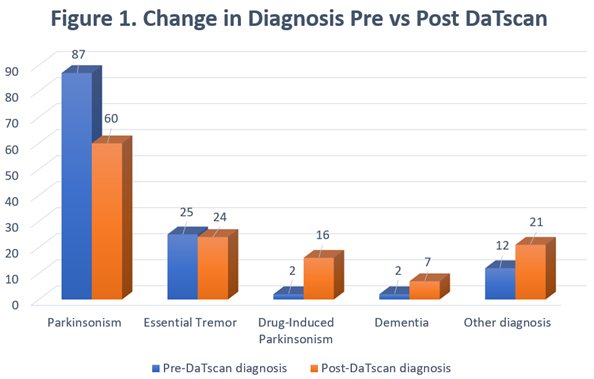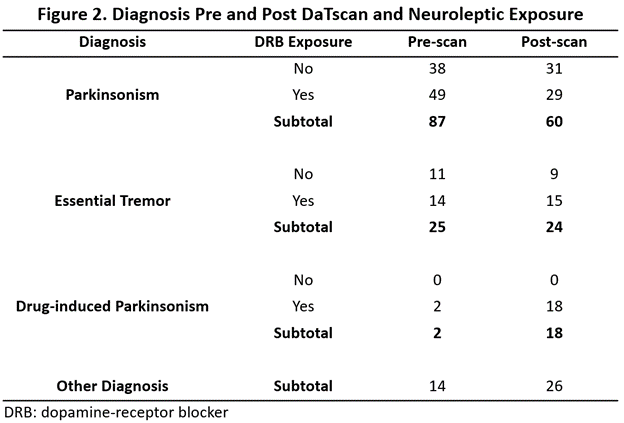Category: Parkinson's Disease: Neuroimaging
Objective: To determine whether Dopamine transporter imaging impacts diagnosis in parkinsonian patients
Background: Dopamine transporter imaging (DaTscan) is a diagnostic tool used to assess loss of presynaptic dopaminergic neurons(1). It allows differentiation of neurodegenerative Parkinsonian syndromes from other non-degenerative etiologies(2). Dopamine receptor blockers are commonly used to treat psychiatric conditions and may cause drug-induced parkinsonism (DIP), which can look identical to PD (3).
Method: We conducted a retrospective chart review of all patients who had a Datscan completed at Emory University, between October 2022 and November 2023. We obtained demographic information, symptom duration, psychiatric diagnosis and neuroleptic medication use.
Results: A total of 166 subjects were obtained, 38 subjects who had DaTscan for research purposes only were excluded.128 subjects were included for data analysis. 51 (39.9%) were female and 77 (60.1%) male, an average age of 70 years [29-94] and a mean duration of symptoms of 4.6 years [1 month-26 years]. 61(46.6%) subjects had a normal DaTscan, and equal number had an abnormal DaTscan. Most common pre-scan diagnosis was Parkinsonism in 87 (67.9%) subjects, followed by ET in 25 (19.5%) and DIP in 2 (1.5%). Most common post-scan diagnosis was Parkinsonism in 60 subjects (46.9%), Essential tremor 24 (18.8%), and drug-induced parkinsonism in 18 subjects (14.1%). 76 (59.3%) subjects had a previous neuroleptic exposure. 43 (56.5%) subjects with neuroleptic exposure had normal DaTscan and 30 (39.4%) subjects had abnormal DaTscan. 50 (39.1%) subjects had a change from initial diagnosis after DaTscan was performed. Post-scan results and neuroleptic exposure: 29/60 (48.3%) subjects with a diagnosis of Parkinsonism and 15/24 (62.5%) subjects with ET were exposed to neuroleptics. All 18 subjects with post-scan diagnosis of drug-induced parkinsonism (14.1%) had neuroleptic exposure. (Figure 1) (Figure 2)
Conclusion: Changes in diagnosis occurred in almost 40% of patients with parkinsonian clinical features after DaTscan was performed. Drug-induced parkinsonism represented the most challenging diagnosis to differentiate clinically from neurodegenerative parkinsonism with 77.7% change between pre and post DaTscan diagnosis.
(Figure 1)
(Figure 2)
References: 1. Bega D, et al. Clinical utility of DaTscan in patients with suspected Parkinsonian syndrome: a systematic review and meta-analysis. NPJ Parkinsons Dis. 2021 May 24;7(1):43. doi: 10.1038/s41531-021-00185-8. PMID: 34031400; PMCID: PMC8144619.
2. Suja Sadasivan, Joseph H. Friedman, Experience with DaTscan at a tertiary referral center, Parkinsonism & Related Disorders, Volume 21, Issue 1, 2015, Pages 42-45, ISSN 1353-8020, https://doi.org/10.1016/j.parkreldis.2014.10.022.
3. Yomtoob J, Koloms K, Bega D. DAT-SPECT imaging in cases of drug-induced parkinsonism in a specialty movement disorders practice. Parkinsonism Relat Disord. 2018 Aug; 53:37-41. doi: 10.1016/j.parkreldis.2018.04.037. Epub 2018 May 5. PMID: 29748111.
To cite this abstract in AMA style:
R. Lopez-Castellanos, S. Factor, R. Blakes. Examination of how DaTscan Impacts Diagnosis in Parkinsonian Patients with and without Dopamine Receptor Blocking Agent Exposure [abstract]. Mov Disord. 2024; 39 (suppl 1). https://www.mdsabstracts.org/abstract/examination-of-how-datscan-impacts-diagnosis-in-parkinsonian-patients-with-and-without-dopamine-receptor-blocking-agent-exposure/. Accessed October 22, 2025.« Back to 2024 International Congress
MDS Abstracts - https://www.mdsabstracts.org/abstract/examination-of-how-datscan-impacts-diagnosis-in-parkinsonian-patients-with-and-without-dopamine-receptor-blocking-agent-exposure/


